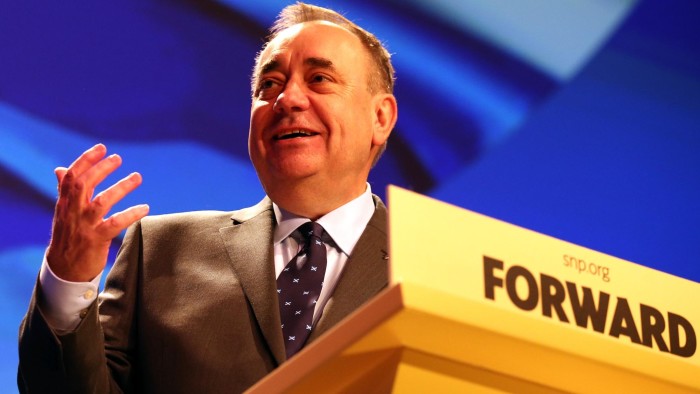SNP girds itself for the ‘last mile to independence’

Roula Khalaf, Editor of the FT, selects her favourite stories in this weekly newsletter.
When Jim Farquharson paid two shillings and six pence to join the Scottish National party more than 50 years ago, it was a fractious fringe force without a single member of parliament and little more than dreams of independence to sustain it.
On Saturday, Mr Farquharson attended an SNP spring conference that underlined its status as Scotland’s most successful political party – and left its members united in the belief they can win September’s referendum on whether to leave the UK.
“Incredible,” the kilt-clad Mr Farquharson said after a final conference session. “I’m 100 per cent confident of a ‘Yes’ vote.”
Such faith is not quite borne out by opinion polls, which still show a lead for the pro-union Better Together campaign and suggest that recent progress for the independence camp may have stalled.
But the SNP insists their canvassing shows steady gains against Better Together, which Alex Salmond, party leader and Scotland’s first minister, called the “most miserable, negative, depressing and thoroughly boring” campaign in modern history.
The SNP used its conference to target Scottish Labour supporters, telling them that leaving the UK would offer a chance to reshape their own party and protect Scotland from Conservative cuts. Mr Salmond said an independent Scottish government could be led by Labour or a coalition, seeking to counter the Better Together portrayal of independence as his personal project,
“A Yes vote in September is not a vote for me, or for an SNP government in 2016,” he said.
He also made efforts to win over women, who remain more sceptical than men. The SNP have made better childcare a central policy of independence. However, a survey by pollster Survation this month found just 35 per cent of women say they will vote Yes, compared with 52 per cent of men.
Mr Salmond announced the promotion of two more women to his cabinet, making it 40 per cent female – the level an independent Scotland would expect from boards of businesses.
How effective such symbolic pledges will be is unclear and Mr Salmond’s comments were dismissed as “drivel” by Margaret Curran, Labour’s shadow Scottish secretary.
But even opponents admit the SNP – which marked its 80th anniversary just before the conference – is a powerful electoral machine, combining the enthusiasm of a political insurgency with the professionalism of a party used to government.
Even after seven years in office in Edinburgh, the SNP has managed to remain popular. Survation found that 45 per cent of voters would vote SNP for the Scottish parliament, compared with just 32 per cent backing Labour.
The conference was also well attended, with more than 1,000 party faithful coming to Aberdeen.
But activists and party leaders do not sound complacent. Noting the start of the “last mile in our journey to independence” after 80 years of effort, Nicola Sturgeon, deputy leader, warned members it might be the “hardest mile of all”.
Mr Farquharson said in the 1960s SNP conferences were more enjoyable, because there was more debate than at the tightly controlled Aberdeen gathering.
The party is also less colourful. In his green kilt and leather sporran, Mr Farquharson stands out in a party that these days largely eschews tartan in favour of sober suits.
But with the SNP fewer than 160 days from the chance to fulfil its nationalist mission, the 71-year-old retired taxi driver had no complaints about the party discipline and lack of free-wheeling discussion. “This is an independence campaign,” he said. “We all have to be on message.”
…
Taking the high road: The SNP’s route to success
1934: The Scottish National party is founded through a merger of the Scottish Party and the National Party of Scotland. The union brings together right and leftwing nationalists to try to create a political force capable of contesting elections against the established UK parties, but early progress is slow.
1945: The SNP wins its first UK parliamentary seat in a by-election, but loses it in a general election just months later. The Conservatives and Labour continue to dominate Scottish politics.
1967: Another by-election victory brings the party back to Westminster, but electoral forces wax and wane over the next few decades. Despite repeated splits, the party benefits from increasing Scottish disillusionment with the UK government under Margaret Thatcher.
1999: The SNP becomes the second largest party in the new devolved Scottish parliament, but the party is plagued by internal disputes.
2007: Forms a minority government in Scotland.
2011: The SNP wins a majority in the Scottish parliament.
Comments